Review of Audley Travel: Luxury bespoke travels
As you know, I’m not a big fan of group tours. They’re fine for a short walking tour, but group tours that go for a week or more just aren’t for me. I like to make my own decisions about where to go, how long to be there, who I travel with, and so on.
Having said that, I love being able to leave the essential items to someone else: accommodations and transport in particular. I can lose hours of my life just choosing a hotel, poring over the hotel listings and reading the reviews.
So I was happy recently to be able to try out tour operator Audley Travel, which plans bespoke “tours” based on clients’ individual interests.
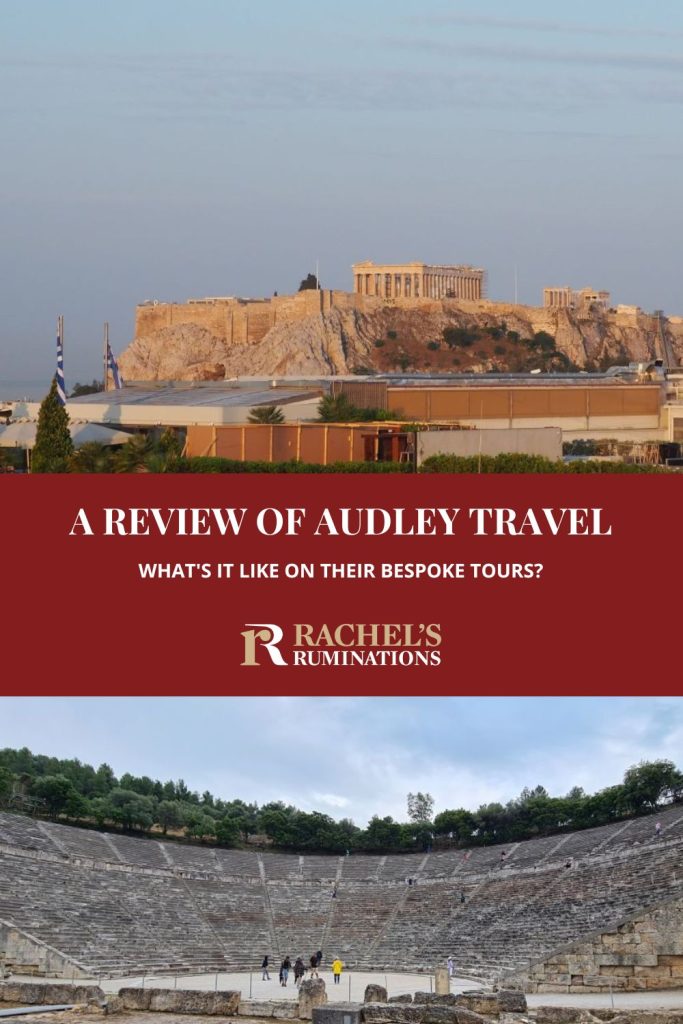
Disclosure: This trip was sponsored by bespoke travel agents Audley Travel. They paid for accommodations, private tours and transport over a four-day period. Nevertheless, they have no influence over what I write. If this review seems quite positive, it’s because I truly loved it!
Another disclosure: This article contains affiliate links. If you click on one and make a purchase, I will receive a small commission.
Hotel in Athens
My tailor-made itinerary started with two nights in the capital city, Athens, at Athens Capital Hotel – Mgallery. This five-star boutique hotel very near the Greek parliament building (where the changing of the guard takes place) and with a view of the Acropolis is simply beautiful. The room I had, while not huge, is tastefully decorated. It has all the extra bells and whistles that every top-end hotel should have – roll-down shutters that completely block the morning sun, sockets by the bed on both sides (electrical, USB and USB-C), tea and coffee machines, and so on. The marble-lined bathroom was also well-supplied, with toiletries of a high-quality brand called Olivia Thinks.
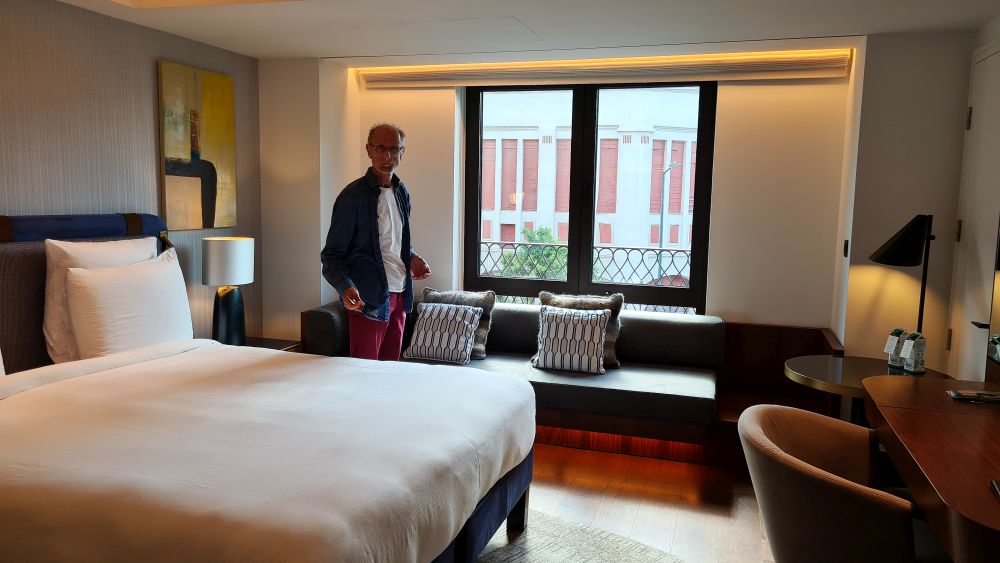
The rooftop has a pool with a glass wall around it, creating a sort of infinity pool look without the vertigo. The view of the Acropolis is splendid from there, if a bit distant. You can also walk up an additional flight of stairs to a small upper level where the entire city is in view. Here’s a tip: if you stay at this hotel, take a look at the Acropolis from the roof at sunrise. At that hour, the city is quiet and the light on the Acropolis is just right.
Service was impeccable. I fell on my first day in Athens and quite badly scraped my knees. When I arrived back at the hotel, the staff were very attentive, providing bandages and crushed ice.
Having said all this, it is an expensive place, starting at about €375 a night, while the room I had starts at about €440. Audley Travel does bespoke luxury travel, so it’s not surprising that they choose the best places, regardless of price.
Book Athens Capital Center Hotel MGallery.
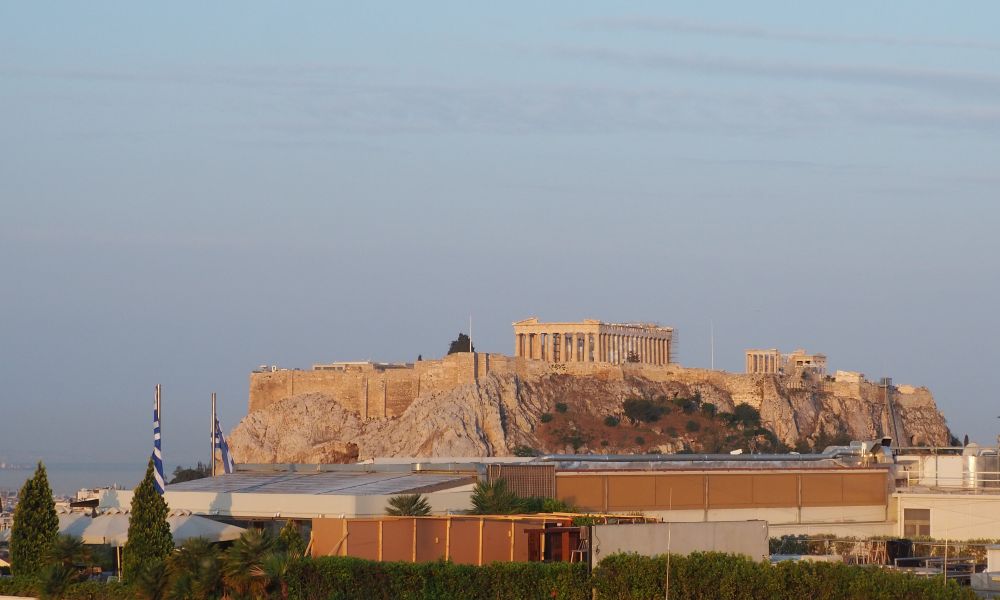
How Audley Travel’s tailor-made itineraries works
As we were planning this trip, Audley’s customer service asked about my interests. Since I’d seen the standard sites like the Acropolis, they suggested a street art walking tour, which I agreed to happily. The rest of my time I had free to make my own choices, including where to eat. Audley only arranges the parts of your trip you want them to arrange. This isn’t an all-inclusive, and thank goodness for that!
Audley Travel’s website shows that they offer tours in dozens of countries, but they caution visitors to view these tours as mere suggestions. Their unique selling point is that their “country specialists,” who have traveled in the country extensively or have lived there, will put together an itinerary to fit your interests. Apparently the company only sells accommodations, tours and transport that they’ve tried out themselves.
Once you’ve chosen what you want, they subcontract with a local company in each place, working with the best tour operators who can provide a truly authentic travel experience. They vet them thoroughly, but leave the actual services to local people. In my case, Greek travel company Siva Travel Services arranged the whole trip. In the case of the street art tour, Siva subcontracted Alternative Athens to provide a private tour for me.
If my experience is any indication, they’ve developed a network of the best travel industry professionals in each country – everyone was on time, professional and knowledgeable. The accommodations were high quality.
Street Art tour in Athens
My tour guide, Nick Tongas, a.k.a. Rude, was excellent (and not at all rude!). He took me through several Athens neighborhoods that were a bit seedy, but also a bit artsy and hip, as is so often the case in the down-at-the-heels neighborhoods in big cities. We saw Gazi, Keramico, Metaxourgio and Psiri. Metaxourgio was the seediest, and Nick warned me to be careful with my things because the area is infested by drug dealers. I put my little backpack in front for this part of the tour but never felt unsafe. This is the beauty of local guides: they can show you local secrets and have first-hand knowledge of the best routes, even if tourists don’t usually want to go there.

We saw lots of high-quality street art and carried out an ongoing discussion about what makes it high quality and what the difference is between graffiti and street art. I was able to use some of what I learned a few years ago on a Berlin street art tour. Because this tour was private, the tour guide could follow my interests.
That meant that, given my interest in history, he shared with me information about the history of the places we passed through as well, like the old marketplace ruins in Keramico, and pointed out particular architectural points of interest too.
If I could hire a private tour guide for every walking tour I take, I would. It’s much less likely to sound scripted and you won’t get slowed down by slow people or stupid questions. Or perhaps I should say that on a private tour you can go as slowly as you want and ask all the stupid questions without embarrassing yourself.
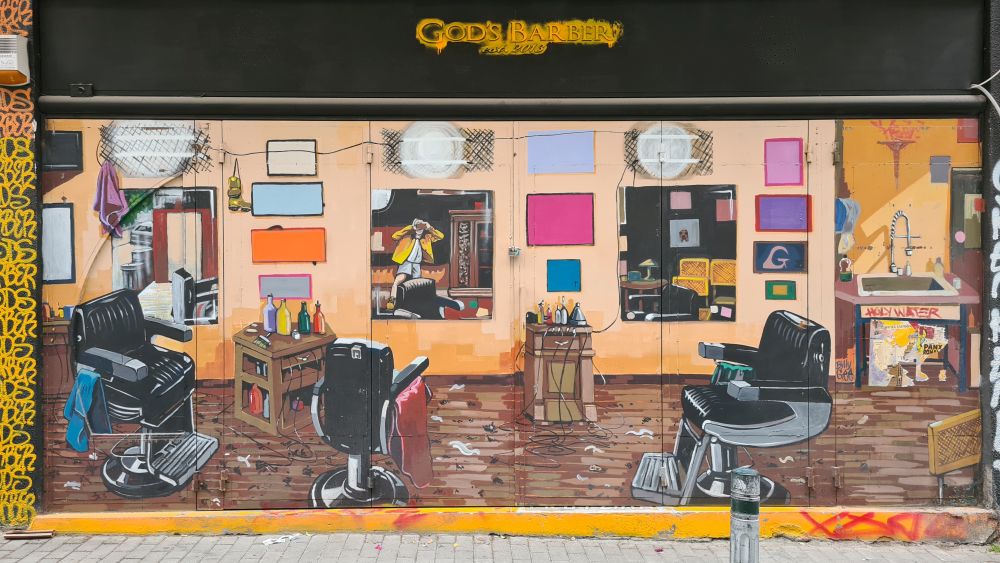
Nick, it turns out, is not just an artist, graphic designer and tour guide, he’s also an entrepreneur. He’s opening a gallery/bar called 1982 near the archeological museum in the Exarcheia neighborhood. Check it out when you visit Athens!
Transfer to Nafplio
When I first checked into the Athens hotel, the receptionist handed me an envelope from Audley containing my itinerary, along with contact numbers for Audley and for Siva. After my two nights in Athens, right on time according to the itinerary, my driver arrived in a neat and comfortable Skoda to take me to my next destination. The plan in the itinerary was that we’d first stop at Korinth, then Epidauros (Epidavros), where we’d meet a guide to show me around. After that, he would take me to my next hotel, this one in Nafplio in the Peloponnese.
Here’s one of the great things about having private transport and the best private guides: I was able to adjust the itinerary as we went. Or rather, the driver did. You see, we started talking and I told him about my new website devoted to World Heritage sites. I said that I hoped to visit Mycenae from Nafplio. Instead, he suggested, why don’t we stop at Mycenae today rather than Korinth?
I so appreciated this kind of personal service! I’d love to see Korinth, but because of my website, UNESCO sites have to take precedence.
Mycenae
Mycenae is old! It is a fortress and city which, at its peak in about 1350 BC, had a population of about 30,000, according to Wikipedia. The Mycenean period is essentially what is considered the earliest phase of ancient Greek civilization, about 1750-1050 BC. At its height, the Bronze-Age Myceneans ruled much of what is now modern-day Greece. They had an alphabet, called Linear B, and traded and/or raided all over the Mediterranean. They worshipped the early versions of the Greek gods.
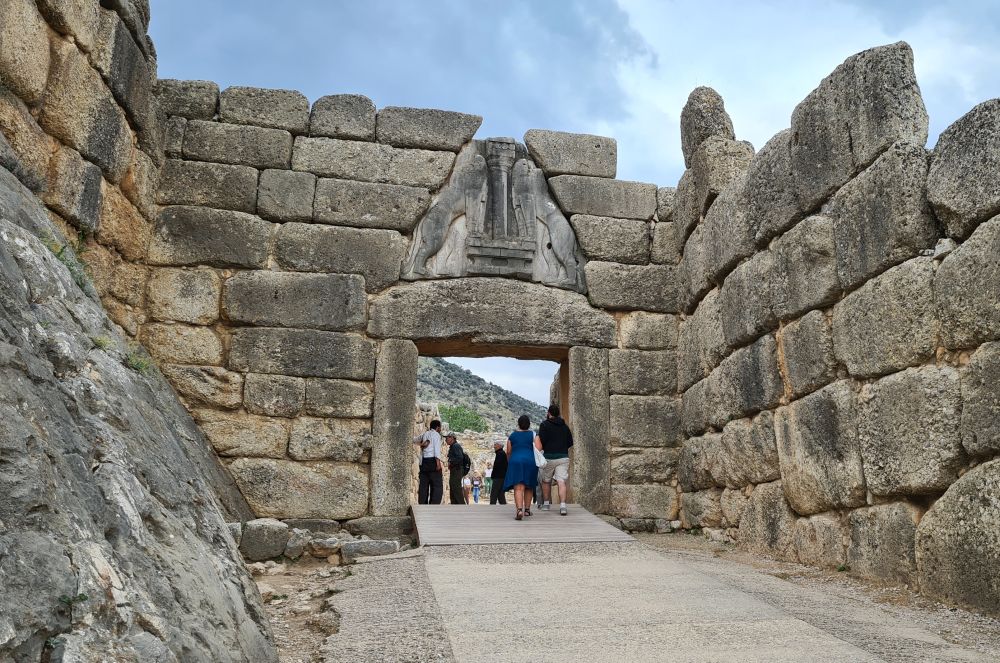
What is left of Mycenae’s citadel are many large, extremely thick walls made out of huge rocks. They defend a point of land far above the sea (274 meters or 900 feet). Inside the walls were a palace and various other structures surrounded by “Cyclopean” walls. Outside the walls, the homes of the city’s population clustered. Today not much is left of the houses but the stone foundation walls.
To me, what was most striking, besides the sheer size of many of the walls and the vast views from the peak, was Grave Circle A, a very large round enclosure where the elite of the city were buried. You can walk around its rim between large vertical slabs of rock.
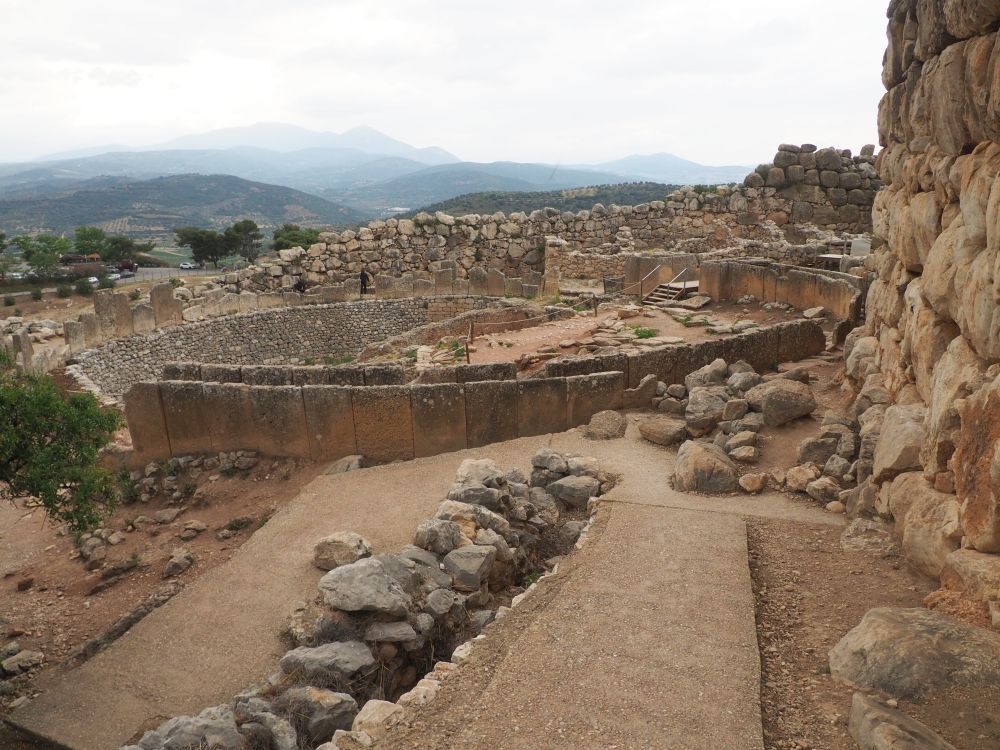
It started raining while I explored Mycenae, so I didn’t spend as much time as I would have liked. Almost no one else was there, and I found the place had a forlorn air of mystery but also of power.
Epidaurus
Our next stop was another UNESCO site, Epidaurus or Epidavros, where I was met by another excellent tour guide arranged by Audley Travel.
Epidaurus is a common stop on the way between Athens and the Peloponnese. It was once a religious sanctuary, but also a spa of sorts, much like Baden-Baden centuries later. Or perhaps it would be better to term it a hospital. Whatever you call it, people worshipped Asclepius, son of the god Apollo, here. He was a god of healing, who they hoped would help cure their ills. At the same time they saw human healers who worked here.
Besides a Doric temple dedicated to Asclepius, there was a hospital, shrines, a dormitory (where supplicants would sleep and see the god in their dreams), a hotel, and so on. The healers who served at the sanctuary kept detailed records carved in stone of the illnesses they and the god treated. The sanctuary flourished from about the 6th century BC, losing importance after the Goths attacked in 395 AD.
The highlight of this archeological site, though, is a large theater. After all, like at the Great Spa Towns of Europe, the people coming to be cured also needed entertainment. Carved into the side of a hill, it is a half-circle of seats around a circular performance area. It seated somewhere between 10,000 and 14,000 people.
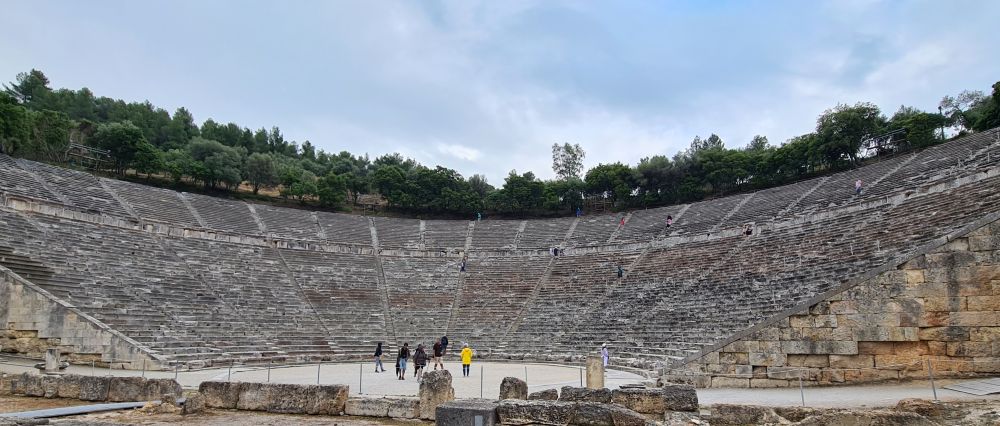
As my guide and I stood in the center of the circular stage, looking up at the concentric half-circles of seats, she began to clap. Here’s what’s special about this theater: the acoustics. I could hear her clapping bouncing off the seats, far louder than the clap right next to me sounded. Even when I huffed and puffed my way nearly to the top of the seating, I could hear her clearly: not only the clapping, but also a simple squeeze of her plastic water bottle. I could even make out when she spoke in a whisper.
Hotel on Nafplio: Grand Sarai Hotel
Bidding farewell to the Epidaurus tour guide, I climbed back in the car and continued on to the hotel in Nafplio. Due to road work, we had to walk about a block in the rain, but the driver scooped up my luggage and carried it for me.
The Grand Sarai Hotel in Nafplio is an old (1685-1715) house that has been renovated into a four-star hotel. It retains some original elements, but has a modern stairway and elevator in its center. While the room I stayed in is somewhat less chic than the one in Athens, it was just as spotlessly clean and is quite a bit larger, with two sofas and a queen-sized bed. The bathroom is also large and modern. It has the added bonus of the kind of shower that shoots water at you from above, at chest height and stomach height, if you want.
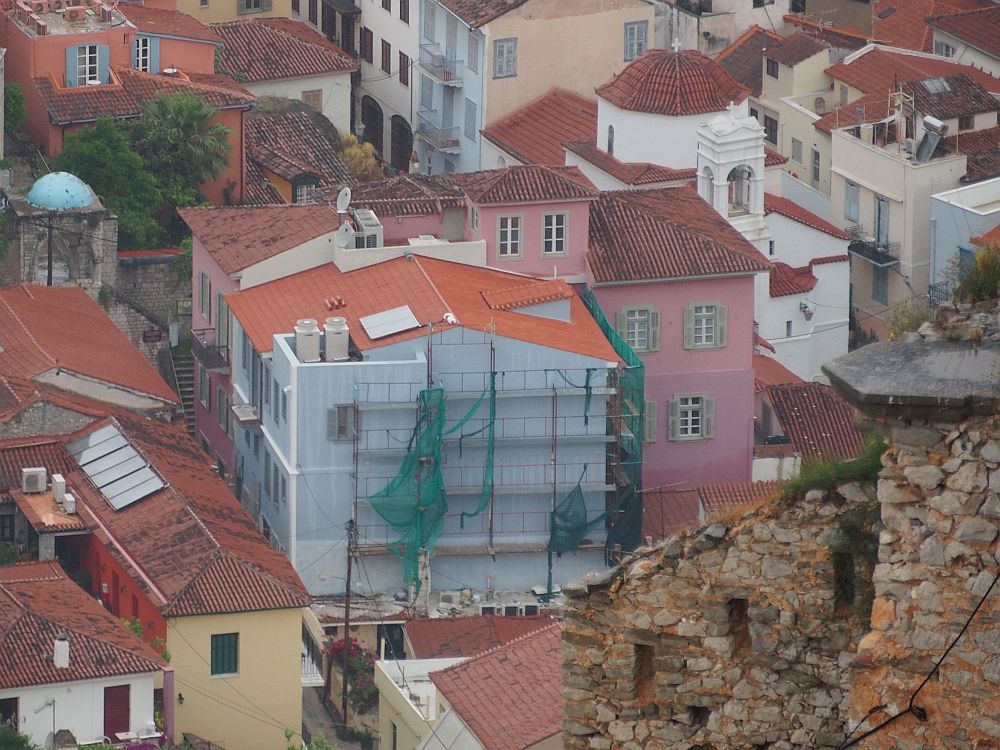
The best part about this room is the view – and I suspect it’s the reason Audley Travel chooses it. I looked out on Palamidi Fortress perched on a mountain. I could also see the long staircase – supposedly 999 steps, but apparently “only” 800+ steps – that leads up to it.
At the recommendation of the hotel’s receptionist, I had a delicious, fresh and freshly-grilled fish with wonderful fried potatoes for dinner at a nearby restaurant.
Book the Grand Sarai Hotel in Nafplio.
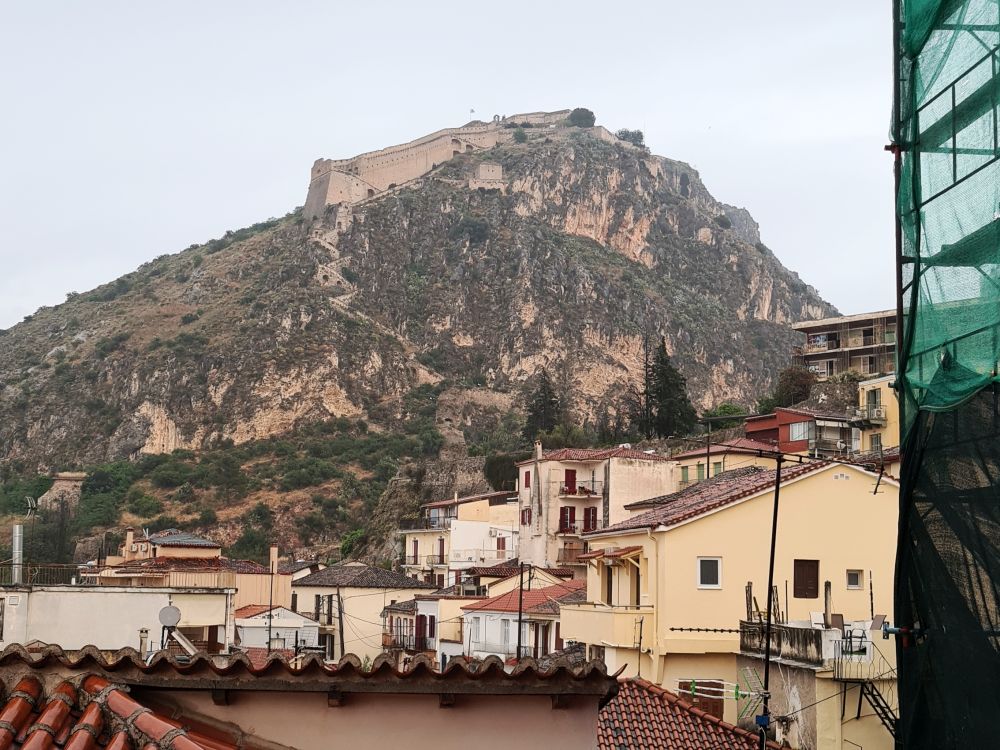
Food tour
For the next morning, Audley had arranged a food tour for me. The woman showing me around told me a bit about the history of the town as well. The focus, though, was on local producers of local specialties. An aspect of sustainable tourism that I especially like is this emphasis on local.
We stopped first at Kostopoulos bakery, which set the tone for the rest of the tour: overabundance. My guide pointed out all the interesting, traditional items – both sweet and savory – that were available, and asked which I’d like. I said I’d like to taste a bit of a particular powdered-sugar-covered cookie and a small taste of orange cake.
That is not what I got. She proceeded to have the bakery fill boxes with full servings of the orange cake, a cream cake, several pieces of spinach pie, a large wedge of pumpkin pie, some rusks, several types of breadsticks, a popular round bread with sesame seeds, and a few of the powdered-sugar cookies. It was a crazy amount of food and only our first stop!
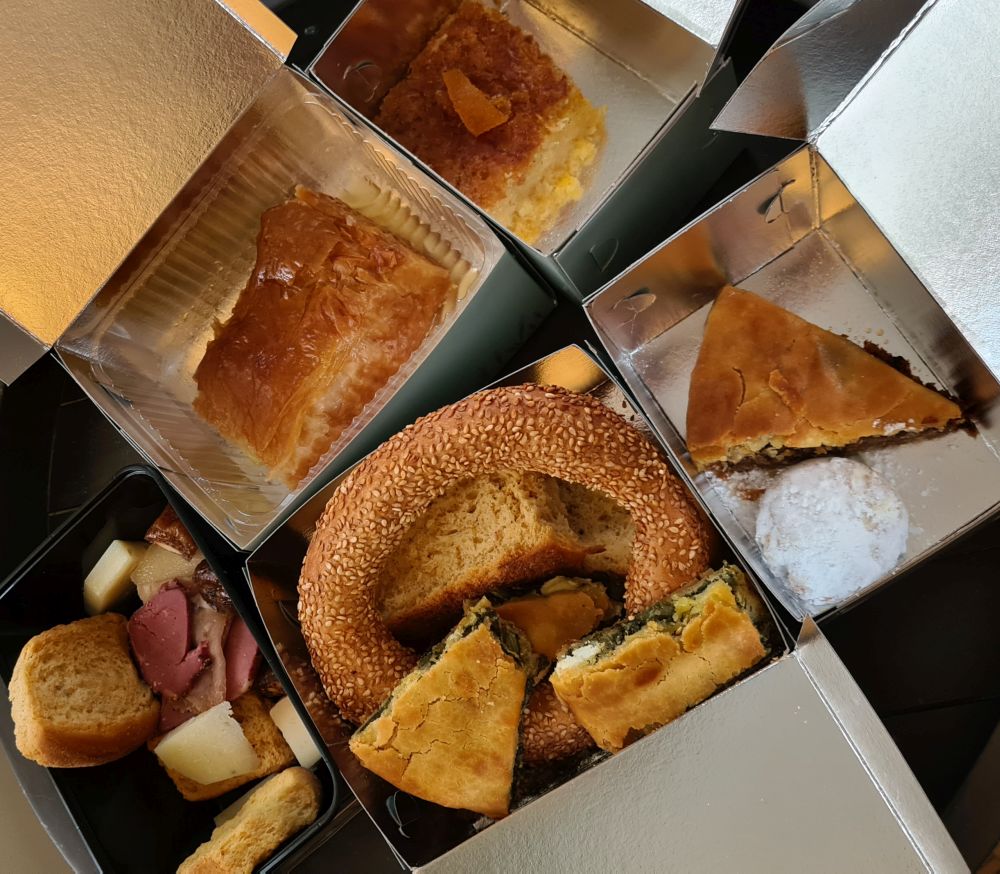
We also visited a delicatessen called Anapliotiko Mpakalico, which was full of all sorts of high-end, artisanal products, including cheese produced by the family of the delicatessen’s owner. The owner had prepared a whole spread of items for me to taste. He explained about his family’s cheese production and had me sample different sorts of cheeses. He also offered me two types of sliced meats, stuffed figs, more rusks, a special kind of tahina, and some extra virgin olive oil, all produced very nearby Nafplio. It was a joy, as I tasted each one, to learn about what it was and how it was made from a person who clearly felt pride at what his family and community produced.
Of course, the guide and the store owner didn’t want any of it to go to waste, so that added another box to the collection of leftovers.
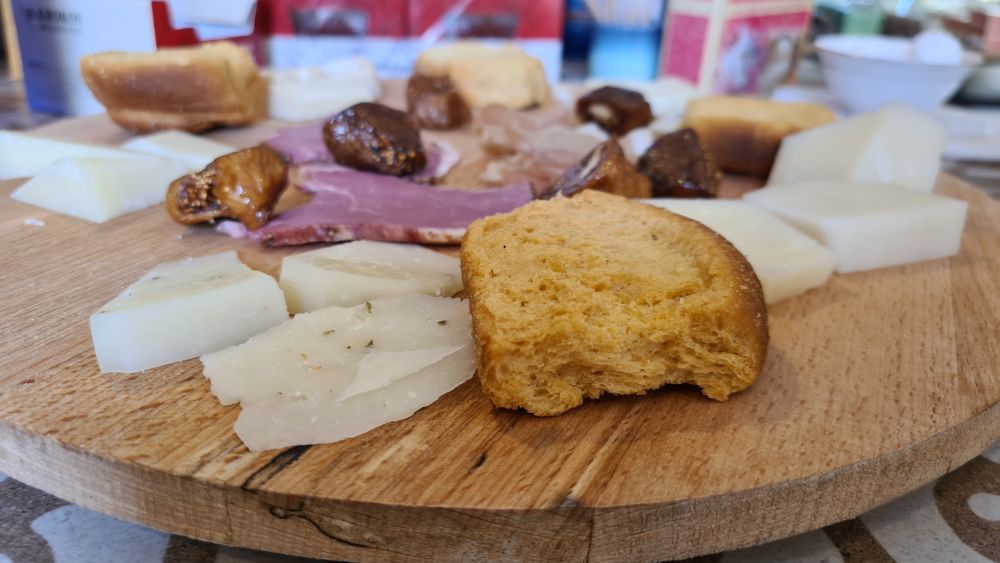
The next stop was Karonis wine shop, where we heard a short explanation about Greek wines and tasted a few. The Greeks make some excellent wines, but with the combination of my full belly and the wine, I got a bit sleepy. Fortunately, this stop did not require me to take any leftovers – I could pour out any wine I didn’t drink.
And lastly, we made a short stop at a shop called Nectar & Ambrosia, a local honey producer. The shopkeeper gave me small tastes – this time actually small! – of various honeys: an orange honey, a wildflower honey, a sage honey, and more. My favorite was definitely the thyme honey. I received a whole lecture from the honey producer and my guide about how I really should eat some honey every day for my health: not cook it in tea, but just eat a spoonful every day.
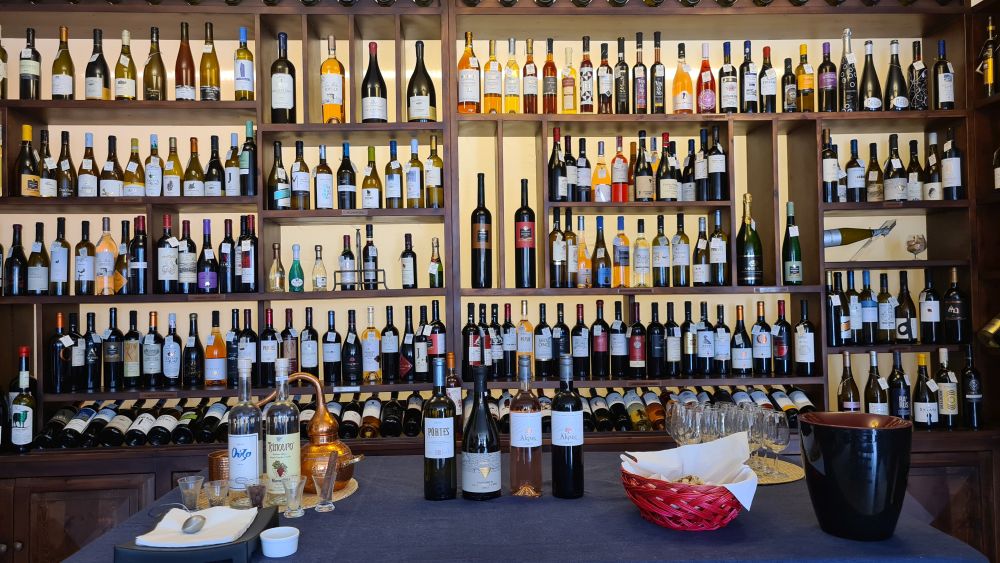
Tiryns
I had the rest of the day with no plans, so I decided to take a taxi – easily available at a central taxi stand in Nafplio – to Tiryns. This site, only about 10 minutes outside Nafplio, is, in combination with Mycenae, a single UNESCO site, dating from the same period of Mycenean rule. It’s less dramatic in terms of its location, which is probably why it’s less known and less visited. It has the same massive walls, though, made from enormous stones. As you climb to its top you can see how, even though it’s not sited on much of a hill, it still offered a clear view of the surrounding plain and the sea.
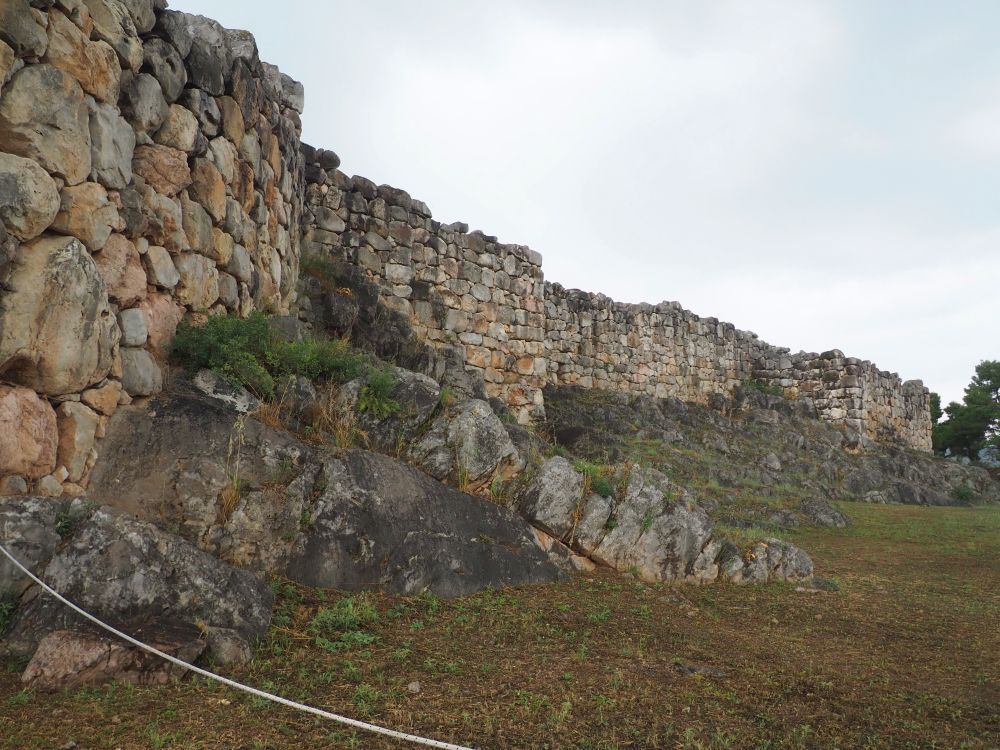
While this short outing to Tiryns was not included in the Audley Tour, it would be easy enough to request it to be included.
Palamidi Fortress
The taxi driver took me straight from Tiryns to the fortress I could see from my room. It was beginning to rain and anyway I wasn’t sure my knees could handle all those stairs. My plan was to take the taxi up and then walk down. Again, this was not in Audley’s itinerary, but could easily be added.
Dating to the early 1700s (the second period of Venetian rule), Palamidi was conquered by the Turks soon after and then by the Greeks in 1822 in the revolution that gained Greece its independence. Like Mycenae, but centuries later, this castle perches on the top of a hill (216 meters or 709 feet), affording it a clear view over land and sea. It has eight bastions, seven of which have a shared wall around them, while one stands separately. Visitors, whether they arrive by stairway or taxi, can walk all around and take in the magnificent views over the old town of Nafplio, the small 15th-century Bourtzi Fortress in the harbor, or the countryside away from the sea.
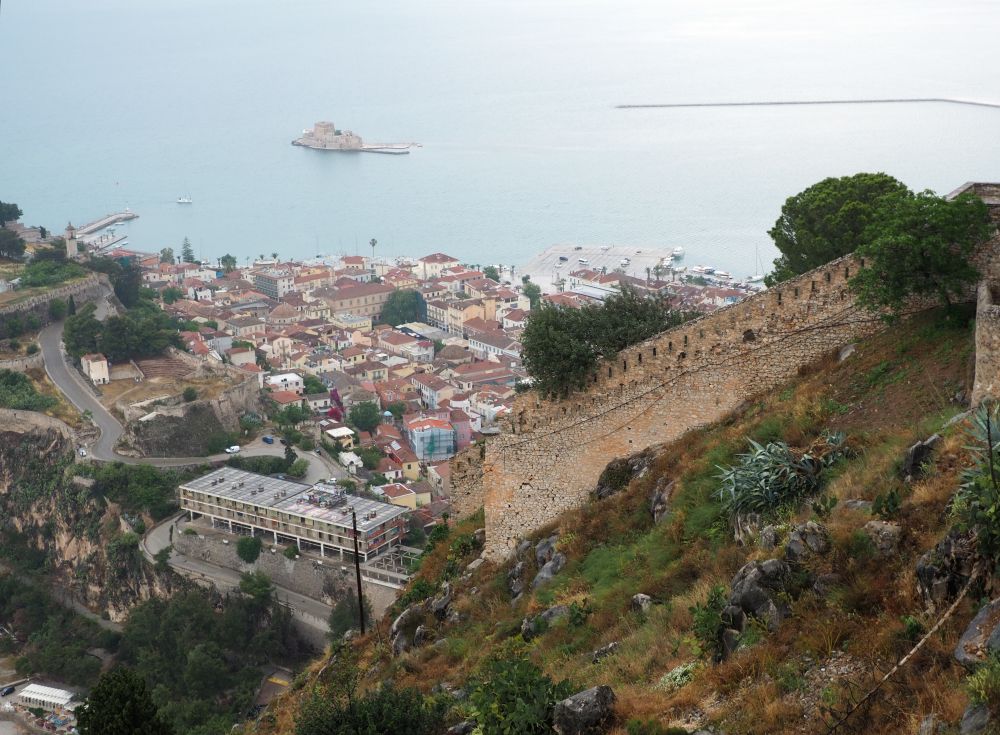
I didn’t end up walking down the stairway after all. The rain got heavier and the paths in the castle were mostly jagged rocks embedded in concrete. This presented two problems for me: my tendency to turn ankles really easily, and the fact that some of the rocks – the marble in particular – became slippery when wet. I managed not to injure myself within the castle, mostly by holding on to walls and walking very slowly and carefully. It just didn’t seem wise to brave so many stairs like this.
I didn’t get to try out another restaurant in Nafplio that evening. Instead, I ate some of the leftover spinach pie, cheese, meats and bread sticks, and that was plenty.
Transfer to Pireaus
Right on time in the morning, a driver arranged by Audley appeared at my hotel, scooped up my luggage, and led me to his car: a Mercedes this time. We didn’t make any stops, but we did have a pleasant conversation about tourism in the Peloponnese. It was interesting to hear his take on the topic.
The driver didn’t just drop me off and leave. Instead, he made sure I was where I needed to be. I was on my way to the island of Agistri but didn’t have a ticket and didn’t know where the boat left from. He waited with my luggage in the car while I bought a ticket and then he drove me to the boat.
What Audley does
This trip was a bit of a taster of what Audley normally does for its clients. I was in Greece anyway for a TBEX conference so Audley did not arrange my flights, but as a bespoke travel agency, that’s something they can do, depending on what the client wants.
I have done this kind of travel a couple of times before. Many years ago I used a similar company here in the Netherlands to book accommodations and transport, but no tours, for a trip in China. It allowed me to focus on what there was to see and not worry about getting from place to place – we were trying to cover a lot of places in a one-month time frame – and that was perfect.
Last year I did an even more intensive trip in Lebanon. In that case, all of the tour was arranged for us by Tourleb. The tour guide (one of the company’s owners) stayed with us the entire time. So did a driver, and all accommodations and meals were provided. In the context of Lebanon, I was glad to have that kind of all-inclusive help, but I wouldn’t want that in most other countries, where I’d want lots of time to explore a place at my own pace. Audley offers a truly bespoke experience, allowing clients to choose anywhere on that spectrum from basic needs like accommodations and transportation to much more constant accompaniment.
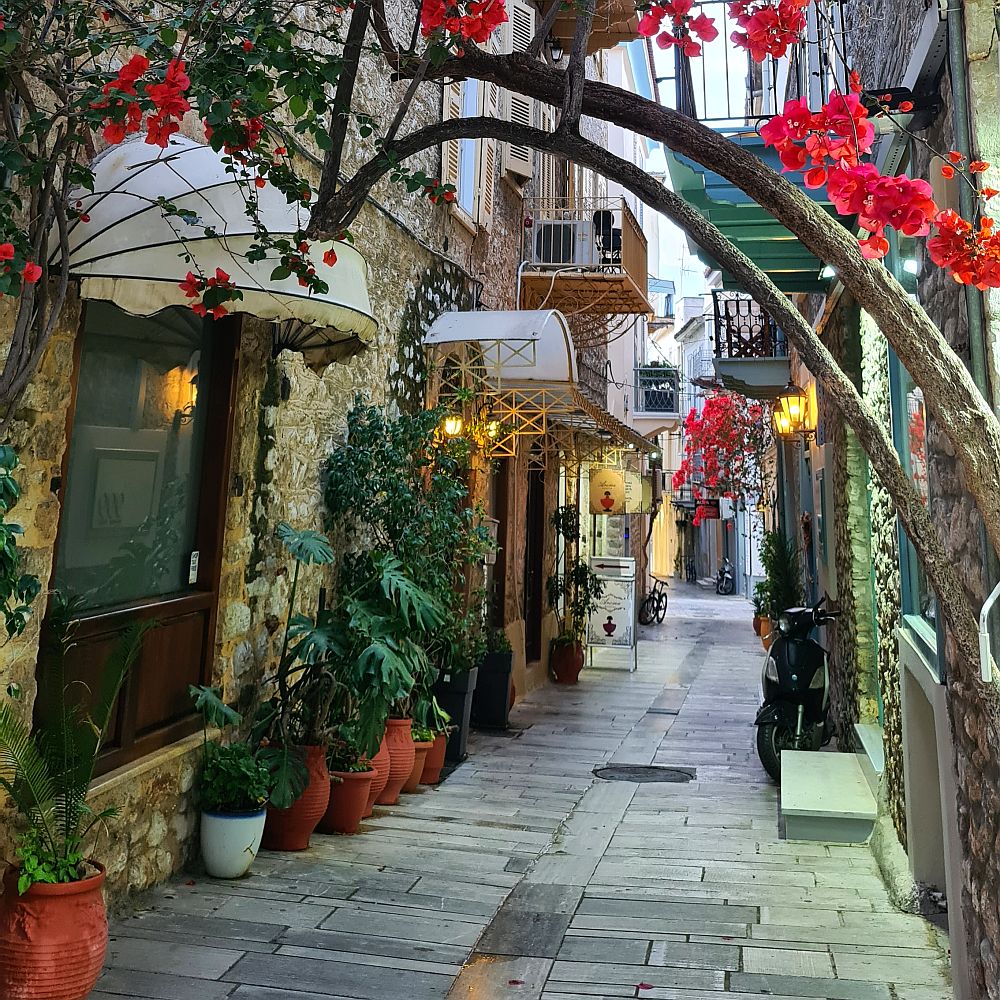
Would I recommend it?
Yes, definitely, if it’s something you can afford. This kind of elite specialist service doesn’t come cheap. As I said at the start of this article, it’s something I’d use much more if my budget allowed. I may still use in countries where I feel less confident about finding my own way around safely.
To give an idea of costs, a typical nine-day itinerary to Athens and the Peloponnese costs from US$5,390 per person (based on two traveling). That would generally include all transfers and accommodations and about four private tours, plus a few other things like a cooking class, a sailboat cruise, and/or a hike with a guide.
Certainly if you are not a very experienced traveler and/or you find planning stressful and/or you just don’t have the time to do the extensive planning that would make you feel confident, this is an excellent solution. Even if you just used Audley for transportation and accommodations, it would relieve most of the stress of traveling. You’d be assured of high-quality services, allowing you to thoroughly enjoy all the best parts of travel without any nasty surprises. No searching for a taxi – and wondering if you’ve been ripped off – no schlepping luggage further than the hotel lobby, no checking into a disappointing hotel, no poor-quality tours or shuffling along with a crowd, and you’d be assured of a friendly voice on the line if you have any concerns. Sounds good to me!
As a bit of icing on the cake, as I was writing this review, Audley announced that they’ve been certified as a B corporation. This indicates that it meets certain standards in terms of sustainability, both environmental and in terms of social responsibility.
Have you ever had a travel agency plan a trip for you like this? Is Audley Travel the kind of service you can see yourself using? Leave a comment below!
My travel recommendations
Planning travel
- Skyscanner is where I always start my flight searches.
- Booking.com is the company I use most for finding accommodations. If you prefer, Expedia offers more or less the same.
- Discover Cars offers an easy way to compare prices from all of the major car-rental companies in one place.
- Use Viator or GetYourGuide to find walking tours, day tours, airport pickups, city cards, tickets and whatever else you need at your destination.
- Bookmundi is great when you’re looking for a longer tour of a few days to a few weeks, private or with a group, pretty much anywhere in the world. Lots of different tour companies list their tours here, so you can comparison shop.
- GetTransfer is the place to book your airport-to-hotel transfers (and vice-versa). It’s so reassuring to have this all set up and paid for ahead of time, rather than having to make decisions after a long, tiring flight!
- Buy a GoCity Pass when you’re planning to do a lot of sightseeing on a city trip. It can save you a lot on admissions to museums and other attractions in big cities like New York and Amsterdam.
- Ferryhopper is a convenient way to book ferries ahead of time. They cover ferry bookings in 33 different countries at last count.
Other travel-related items
- It’s really awkward to have to rely on WIFI when you travel overseas. I’ve tried several e-sim cards, and GigSky’s e-sim was the one that was easiest to activate and use. You buy it through their app and activate it when you need it. Use the code RACHEL10 to get a 10% discount!
- Another option I just recently tried for the first time is a portable wifi modem by WifiCandy. It supports up to 8 devices and you just carry it along in your pocket or bag! If you’re traveling with a family or group, it might end up cheaper to use than an e-sim. Use the code RACHELSRUMINATIONS for a 10% discount.
- I’m a fan of SCOTTeVEST’s jackets and vests because when I wear one, I don’t have to carry a handbag. I feel like all my stuff is safer when I travel because it’s in inside pockets close to my body.
- I use ExpressVPN on my phone and laptop when I travel. It keeps me safe from hackers when I use public or hotel wifi.
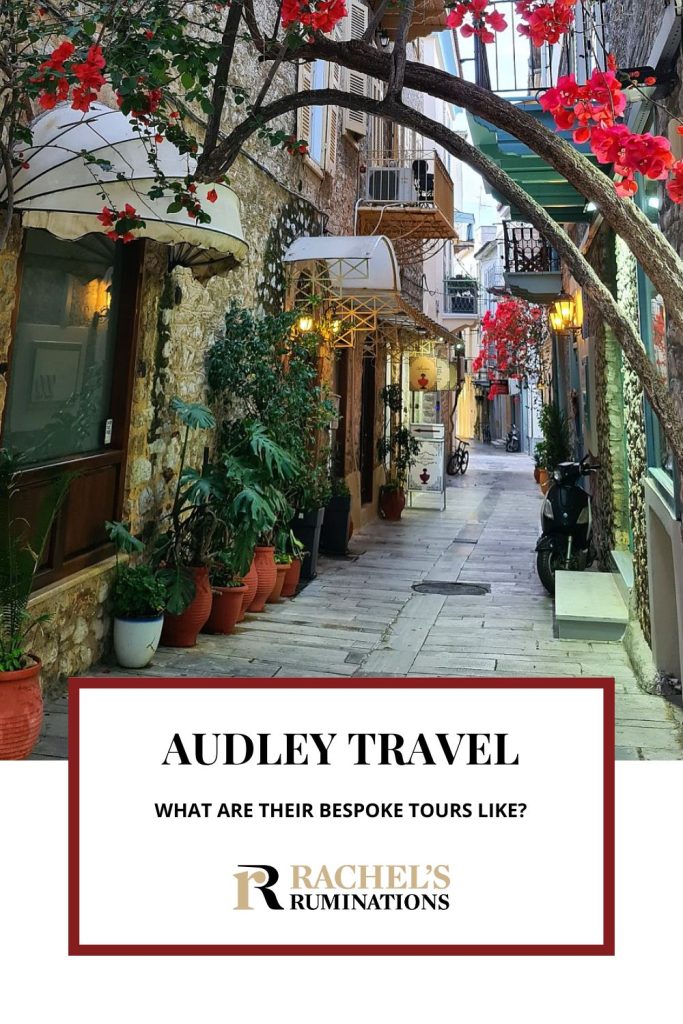



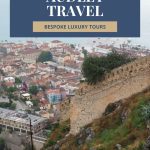


Nice Blog!
Great blog. Thank you for the details. I am actually contemplating booking with Audley Travel (for a trip to Morocco) and found your comments about the company especially helpful.
Lucky you! Do it!
I came across this blog and noticed your comment about Morocco. We used Audley for a trip to Morocco before the pandemic, they did a great job at picking hotels and made our trip seamless as we visited four cities. We had one driver for the entire trip. Guides were welcoming and knowledgeable.
Good to know it is all as seamless in Morocco as it was for me in Greece. Thanks for commenting!